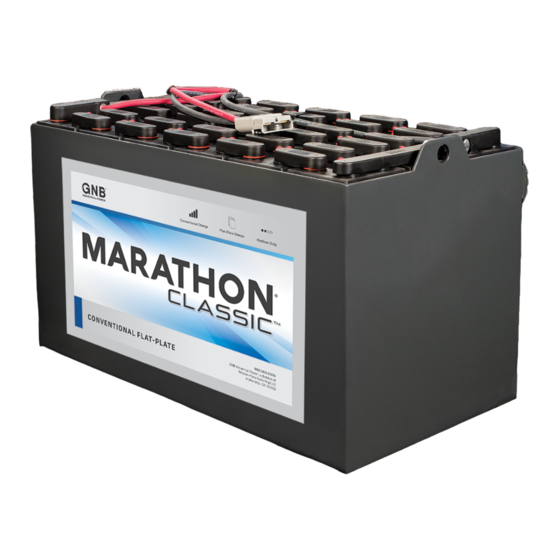Advertisement
Quick Links
FLOODED FLAT-PLATE MOTIVE POWER BATTERIES
CAUTION - READ THE ENTIRE INSTALLATION AND OPERATING INSTRUCTIONS BEFORE PLACING BATTERIES IN SERVICE.
1 . SAFETY
1.1 Follow your company's Safety Instructions when
working with or near diesel starting batteries.
Observe the caution label affixed to the battery.
Thoroughly familiarize yourself with industry and
government guidelines (OSHA, ANSI) for charging,
handling and maintaining diesel batteries.
1.2 Assign battery and charger care to properly trained
personnel.
1.3 This b attery c ontains s ulfuric a cid. A void c ontact w ith
skin, eyes, or clothing. Wear rubber apron, gloves,
boots and goggles or face shield when handling,
checking, filling, charging or repairing batteries.
1.4 Keep water readily available for flushing spilled
electrolyte from eyes or skin. Use plain water only
and obtain medical attention immediately. Special
deluge showers and eye wash basins are required.
1.5 Batteries produce hydrogen during charge. Keep
open flames away. Do not check electrolyte level
with a cigarette lighter or match. Use a flashlight or
permanent lights. Do not smoke or create sparks.
1.6 Lift batteries with a hoist, crane, lift truck, or similar
equipment. Move batteries on trucks, conveyors
or rollers. Be sure to place a rubber mat or similar
insulating material across tops of batteries without
covers when handling. Make sure equipment is of
ample strength and properly installed.
CAUTION: Do not use chain or wire rope slings.
1.7 Never lay metal tools, such as wrenches or other
material on top of a battery.
1.8 Disconnect the battery from the locomotive when
performing maintenance and repair on the motor
or electrical system.
1.9 Open or "break" the battery circuit before
attempting repairs to terminal connections.
1.10 Apply a strong neutralizer, like baking soda, when
acid is spilled on the floor. Check local regulations
regarding disposal of neutralized waste.
INSTALLATION AND OPERATING INSTRUCTIONS
2. RECEIVING BATTERIES
I mmediately upon receipt of shipment, examine the
outside of the packing for signs of rough handling
before accepting battery from carrier. Wet spots on
the shipping pallet may be an indication of leaking jars
broken in shipment.
I f there is evident damage, the receipt should be signed
and both copies (carrier's and receiving copies) marked
"Shipment Received Damaged". The carrier should
be called immediately and asked to make a "Carrier's
Inspection for Damage Report".
I f "concealed" damage is later detected, the carrier
should be called immediately and requested to
make a "Carrier's Inspection for Concealed Damage
Report." After inspection by the carrier, arrangements
should be made with the local GNB
representative to have the battery repaired before
placing it in service.
CAUTION
Before placing a battery in service,
review and adhere to the Safety
Guidelines listed in Section 1.
3. PLACING IN SERVICE
V erify that the battery weight meets or exceeds the
minimum truck weight requirements. Allow the battery
to cool or warm to room temperature before charging
or adding water. Make sure the battery charger is
properly matched to the battery. Use a charger with
automatic charger termination controls.
R emove the vent caps from each cell and check to see
that the electrolyte level is above the plates. If it is
obvious that the electrolyte has spilled out of any cells,
replace it with electrolyte of the same specific gravity
as found in the other cells of the battery. Replace the
vent caps and give the battery a freshening charge
until there is no increase in specific gravity for three
hydrometer readings taken at one hour intervals.
D uring shipment of the battery, low temperatures and/
or normal shock and vibration often results in a drop
in the electrolyte level.
®
Industrial Power
®
Advertisement

Summary of Contents for GNB Marathon Classic
- Page 1 1.4 Keep water readily available for flushing spilled Report.” After inspection by the carrier, arrangements electrolyte from eyes or skin. Use plain water only should be made with the local GNB Industrial Power ® and obtain medical attention immediately. Special representative to have the battery repaired before deluge showers and eye wash basins are required. placing it in service.
- Page 2 • I nspect the charger. Confirm proper output voltage charge rate should taper down to the finish rate by the and current. Check for external damage, frayed time the battery is 85% charged and may be even lower cables, or worn connectors. when fully charged. High “on charge” temperatures • Clean the exterior of the battery . or frequent need for water additions are indications TROUBLE SIGNS of overcharging. Short running times and/or low end- Battery temperature averages more than 125°F. of-charge specific gravities may indicate inadequate Open circuit cell voltages vary by 0.15 volts or more recharge. Consult your local GNB Industrial Power and specific gravity varies by 0.020 or more during representative on specific charging problems. equalizing. T he ampere-hour rating of the char ger applied to The top of the battery is always wet or one cell the battery should be within 10% of the ampere-hour requires excessive water. rating of the battery.
- Page 3 Remove them only to observe electrolyte levels, make maintenance and repair service available. GNB water additions, take temperatures, or take specific Industrial Power can also supply all of your battery, gravity readings with a hydrometer. If the battery charger, and accessory device replacement part needs. requires cleaning, contact your local GNB Industrial For more information in the U.S.A. and Canada, call Power servicing representative. The solution used to 1-888-563-6300. All others, please contact your local clean and neutralize the outside of the batteries should GNB Industrial Power battery sales representative. be disposed of in an environmentally safe manner. 9. WATER ADDITIONS 11.

